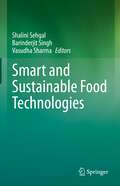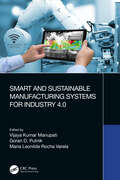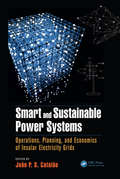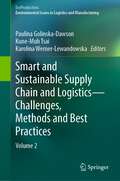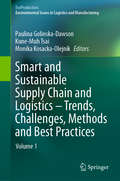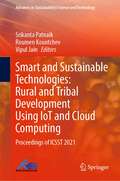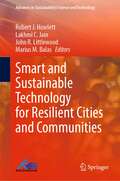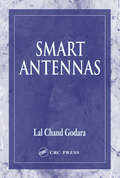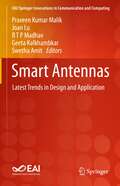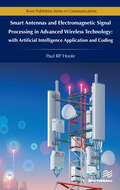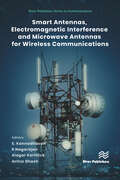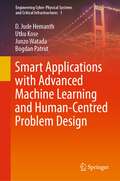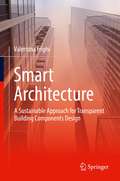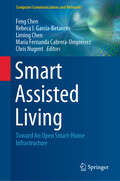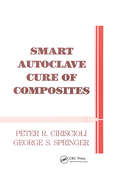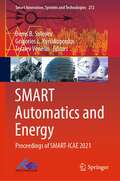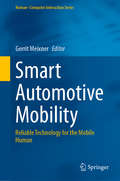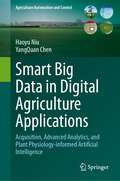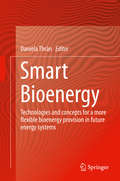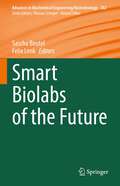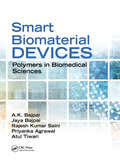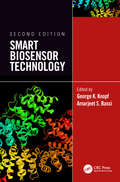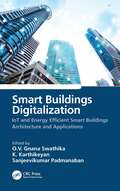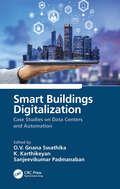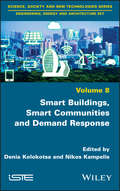- Table View
- List View
Smart and Sustainable Food Technologies
by Shalini Sehgal Barinderjit Singh Vasudha SharmaThis book presents a comprehensive view of emerging smart technologies in various food processing sectors. Specifically, it covers smart technologies applied in food production, food manufacturing, food packaging, storage, distribution, and food supply chain. Contributing authors are the key scientists with diverse backgrounds in either industry or academia.The book contains four parts with four chapters each, presenting recent smart technologies developed in their respective areas. Part I primarily focuses on the recent smart food production innovations such as precision agriculture, vertical farming, automation, robotics , livestock technology, modern greenhouse practices, artificial intelligence, and block chain that dramatically increase the quality of raw materials for the food industry. Part II provides the current knowledge and developments related to the recent smart technologies in manufacturing pertaining to various food sectors, non-thermal food preservation technologies, and 3D printing, developed for the food manufacturing industries that improve the organoleptic and nutritional quality, enhance chemical and microbial safety, as well as cost-effectiveness and convenience of processed foods. Part III covers smart technologies to ensure food safety in the supply chain, with monitoring and surveillance of food contamination, use of IoT and blockchain for food traceability and neural network approach for risk assessment. Part IV provides expert opinions on using smart technologies for minimizing waste and maximizing co-product recovery in food processing; upcycling technologies in food and sustainable value stream mapping in the food industry.This book will be a useful resource to graduate/undergraduate students and researchers in advanced food technology, practicing technologists/engineers in the food and related industries, food packaging industry, entrepreneurs and other scientists and technologists in smart and sustainable processes who seek information on design and development of these processes.
Smart and Sustainable Manufacturing Systems for Industry 4.0
by Vijaya Kumar Manupati Goran D. Putnik Maria Leonilde Rocha VarelaThe current perspectives of smart and sustainable manufacturing systems hold important implications for current practices and understanding these concepts for further implications. This comprehensive reference text discusses both centralized and decentralized production systems, using variety of new cutting-edge approaches to solve the problem.The text covers simulation-based approaches including social network-based approaches, discrete event-based approaches, and knowledge based for smart and sustainable systems. It further covers mathematical models such as single-objective, multi-objective, and many-objective. The text discusses important topics including energy efficiency, transportation constrains for efficient and effective production, meta-heuristic and hybrid algorithms, and real-time monitoring and analysis for smart and sustainable production.This book- • Presents approaches to improve the objectives of sustain-ability and smart production systems. • Discusses Internet of Things (IoT) and Industrial Internet of Things (IIoT) concepts and its implementation for production systems. • Covers social network analysis method in distributed manufacturing systems. • Examines reckoning prognostics and diagnostics to monitor the health of the systems in perspective of distributed manufacturing. • Discusses aspects of Industry 4.0 in specific production systems. The text will be useful for graduate students and professional in the fields of mechanical engineering, production engineering, industrial engineering, and manufacturing.
Smart and Sustainable Power Systems: Operations, Planning, and Economics of Insular Electricity Grids
by João P. CatalãoThe smart grid initiative, integrating advanced sensing technologies, intelligent control methods, and bi-directional communications into the contemporary electricity grid, offers excellent opportunities for energy efficiency improvements and better integration of distributed generation, coexisting with centralized generation units within an active network. A large share of the installed capacity for recent renewable energy sources already comprises insular electricity grids, since the latter are preferable due to their high potential for renewables. However, the increasing share of renewables in the power generation mix of insular power systems presents a significant challenge to efficient management of the insular distribution networks, mainly due to the variability and uncertainty of renewable generation. More than other electricity grids, insular electricity grids require the incorporation of sustainable resources and the maximization of the integration of local resources, as well as specific solutions to cope with the inherent characteristics of renewable generation. Insular power systems need a new generation of methodologies and tools to face the new paradigm of large-scale renewable integration. Smart and Sustainable Power Systems: Operations, Planning, and Economics of Insular Electricity Grids discusses the modeling, simulation, and optimization of insular power systems to address the effects of large-scale integration of renewables and demand-side management. This practical book: Describes insular power systems, renewable energies, uncertainty, variability, reserves, and demand response Examines state-of-the-art forecasting techniques, power flow calculations, and scheduling models Covers probabilistic and stochastic approaches, scenario generation, and short-term operation Includes comprehensive testing and validation of the mathematical models using real-world data Explores electric price signals, competitive operation of distribution networks, and network expansion planning Smart and Sustainable Power Systems: Operations, Planning, and Economics of Insular Electricity Grids provides a valuable resource for the design of efficient methodologies, tools, and solutions for the development of a truly sustainable and smart grid.
Smart and Sustainable Supply Chain and Logistics — Challenges, Methods and Best Practices: Volume 2 (EcoProduction)
by Paulina Golinska-Dawson Kune-Muh Tsai Karolina Werner-LewandowskaThe application of artificial intelligence methods and the increasing digitalization of the processes in a supply chain contribute the more seamless flow of materials and information. The disturbances in global supply chain during pandemic put pressure on companies to improve the existing operations. The Sustainable Development Goals put pressure on local and global markets to reduce carbon dioxide emissions and to implement a more resource-efficient business model. Integration of physical and cyber systems is necessary to achieve more environmentally friendly, efficient logistics and supply chain operations. This book presents the contemporary issues of sustainability and integration of physical and information flow in supply chain. In the individual chapters, the authors discuss new qualitative and qualitative theoretic methods, models and present case studies from business practice. This book might be a valuable source of knowledge for the academics, PhD students and practitioners to deepen their knowledge in the field of logistics and SCM.
Smart and Sustainable Supply Chain and Logistics – Trends, Challenges, Methods and Best Practices: Volume 1 (EcoProduction)
by Paulina Golinska-Dawson Kune-Muh Tsai Monika Kosacka-OlejnikThis book discusses the critical contemporary issues of sustainability and integration of physical and information flow. It explores the digitalization of logistics processes and the need for a more integrated and a seamless cooperation in supply chain management, which are dominant trends in business practice. Moreover, it examines how the pressure for CO2 emission reductions and more resource- efficient business models influences the organization of logistics operations on both a local and global scale, demonstrating that integrating physical and cyber systems is necessary to achieve a more environmentally friendly, safe logistics and supply chain operations. In the individual chapters, the authors discuss the new qualitative and quantitative theoretical methods and models and also analyze case studies from business practice. This book provides valuable insights for academics, Ph.D. students and practitioners wishing to deepen their understanding of logistics operations and management.
Smart and Sustainable Technologies: Proceedings of ICSST 2021 (Advances in Sustainability Science and Technology)
by Srikanta Patnaik Roumen Kountchev Vipul JainThis book presents a collection of peer-reviewed best selected research papers presented at the First International Conference on Smart and Sustainable Technologies (ICSST 2021), organized by Department of ECE, GIET University, Gunupur, Rayagada, Odisha, India, during December 16–18, 2021. The proceedings of the conference have a special focus on the developments of local tribe and rural people using smart and sustainable technologies. It is an interdisciplinary platform for researchers, practitioners, and educators as well as NGO workers who are working in the area of web engineering, IoT and cloud computing, Internet of Everything, data science, artificial intelligence, machine learning, computer vision, and intelligent robotics, particularly for the rural and tribal development.
Smart and Sustainable Technology for Resilient Cities and Communities (Advances in Sustainability Science and Technology)
by Lakhmi C. Jain Robert J. Howlett John R. Littlewood Marius M. BalasThis book is a collection of extended versions of papers presented at the KES Covid-19 Challenge international summit. The book focusses on technological, economic, and social developments to combat the effects of global and local disasters as well as the ways in which the recovery from Covid can be used to build more resilient and sustainable communities, industry, and improve the environment. It also discusses the global challenges of human-influenced climate change. There are chapters on making cities and communities more resilient through energy self-sufficiency, food production, resilient housing and buildings, human health and intelligent systems e.g. for forecasting and prediction.
Smart Antennas (Electrical Engineering And Applied Signal Processing Ser.)
by Lal Chand GodaraThe use of smart antennas to increase mobile communications channels has re-ignited research and development in the field. Practicing engineers are eager to discover more about this subject, and need a comprehensive book that can provide a learning platform and prevent the loss of time spent on searches through journal literature.Smart Ante
Smart Antennas: Latest Trends in Design and Application (EAI/Springer Innovations in Communication and Computing)
by Praveen Kumar Malik Joan Lu B T P Madhav Geeta Kalkhambkar Swetha AmitThis book presents the latest techniques for the design of antenna, focusing specifically on the microstrip antenna. The authors discuss antenna structure, defected ground, MIMO, and fractal design. The book provides the design of microstrip antenna in terms of latest applications and uses in areas like IoT and device-to-device communication. The book also provides the current methods and techniques used for the enhancement of the performance parameters of the microstrip antenna. Chapters enhance the knowledge and skills of students and researchers in the latest in the communications world like IoT, D2D, satellite, wearable devices etc. The authors discuss applications such as microwave imaging, medical implants, hyperthermia treatments, and wireless wellness monitoring and how a decrease in size of antenna help facilitate application potential.Provides the latest techniques used for the design of antenna in terms of its structure, defected ground, MIMO and fractal design;Outlines steps to resolve issues with designing antenna, including the latest design and design parameters for microstrip antenna;Presents the design of conformal and miniaturized antenna structures for various applications.
Smart Antennas and Electromagnetic Signal Processing in Advanced Wireless Technology
by Paul R.P. HooleThe book addresses the current demand for a scientific approach to advanced wireless technology and its future developments. It gives a clear presentation of both antennas and adaptive signal processing which is what makes antennas powerful, maneuverable and necessary for advanced wireless technology. The book presents electromagnetic signal processing techniques that both control the antenna beam and track the moving station, which is required for effective, fast, dynamic beamforming.The first part of the book presents a comprehensive description and analysis of basic antenna theory, starting from short dipole antennas to array antennas. This section also includes important concepts related to antenna parameters, electromagnetic wave propagation, the Friis equation, the radar equation and wave reflection and transmission through media.The second part of the book focuses on smart antennas, commencing from a look at the traditional approach to beamforming before getting into the details of smart antennas. Complete derivation and description of the techniques for electromagnetic field signal processing techniques for adaptive beamforming are also presented. Artificial Intelligence (AI) driven beamforming is presented using computationally fast and low-memory demanding technique for AI beamforming is presented with the different excitation functions available. A novel method for fast, low memory and accurate, maneuverable single beam generation is presented, as well as other methods for beamforming with fewer elements along with a simple method for tracking the mobile antenna and station. In this section, for completeness, the use of antenna signal processing for synthetic aperture techniques for imaging is also presented, specifically the Inverse Synthetic Aperture Imaging technique.The third part of the book presents technological aspects of advanced wireless technology, including the 5G wireless system and the various devices needed to construct it. While the books’ main emphasis is theoretical understanding and design, it includes applications, and legal matters are also presented.
Smart Antennas, Electromagnetic Interference and Microwave Antennas for Wireless Communications
by S. Kannadhasan R. Nagarajan Alagar Karthick Aritra GhoshThis book covers all areas of smart antennas, electromagnetic interference, and microwave antennas for wireless communications. Smart antennas or adaptive antennas are multi-antenna components on one or both sides of a radio communication connection, combined with advanced signal processing algorithms. They've evolved into a critical technology for third-generation and beyond mobile communication systems to meet their lofty capacity and performance targets. It seems that a significant capacity gain is achievable, particularly if they are employed on both sides of the connection. There are several essential characteristics of these systems that need scientific and technical investigation. Included in the book are beamforming, massive MIMO, network MIMO, mmwave transmission, compressive sensing, MIMO radar, sensor networks, vehicle-to-vehicle communication, location, and machine learning.
Smart Applications with Advanced Machine Learning and Human-Centred Problem Design (Engineering Cyber-Physical Systems and Critical Infrastructures #1)
by D. Jude Hemanth Utku Kose Junzo Watada Bogdan PatrutThis book brings together the most recent, quality research papers accepted and presented in the 3rd International Conference on Artificial Intelligence and Applied Mathematics in Engineering (ICAIAME 2021) held in Antalya, Turkey between 1-3 October 2021. Objective of the content is to provide important and innovative research for developments-improvements within different engineering fields, which are highly interested in using artificial intelligence and applied mathematics. As a collection of the outputs from the ICAIAME 2021, the book is specifically considering research outcomes including advanced use of machine learning and careful problem designs on human-centred aspects. In this context, it aims to provide recent applications for real-world improvements making life easier and more sustainable for especially humans. The book targets the researchers, degree students, and practitioners from both academia and the industry.
Smart Architecture – A Sustainable Approach for Transparent Building Components Design
by Valentina FrighiThis book explores the specific role that glazing technologies play within the world of smart architecture as important components of contemporary and future sustainable architectural and technological research. Smart Architecture begins with a definition of the concept of “smart” in architecture and examines how innovative technologies and materials have shaped buildings over the years. The author then provides a supporting database of contemporary smart architecture—mapping adopted strategies, recognizing common patterns, and evaluating current and future trends in the context of smart building envelopes, energy efficiency, and the development of high-potential innovative building components. The book proceeds with a focus on the specific role that glazing technologies play in this framework and provides a systematic methodology to quantify options for the effective integration of transparent building components within advanced and innovative building envelope systems.
Smart Assisted Living: Toward An Open Smart-Home Infrastructure (Computer Communications and Networks)
by Feng Chen Rebeca I. García-Betances Liming Chen María Fernanda Cabrera-Umpiérrez Chris NugentSmart Homes (SH) offer a promising approach to assisted living for the ageing population. Yet the main obstacle to the rapid development and deployment of Smart Home (SH) solutions essentially arises from the nature of the SH field, which is multidisciplinary and involves diverse applications and various stakeholders. Accordingly, an alternative to a one-size-fits-all approach is needed in order to advance the state of the art towards an open SH infrastructure.This book makes a valuable and critical contribution to smart assisted living research through the development of new effective, integrated, and interoperable SH solutions. It focuses on four underlying aspects: (1) Sensing and Monitoring Technologies; (2) Context Interference and Behaviour Analysis; (3) Personalisation and Adaptive Interaction, and (4) Open Smart Home and Service Infrastructures, demonstrating how fundamental theories, models and algorithms can be exploited to solve real-world problems.This comprehensive and timely book offers a unique and essential reference guide for policymakers, funding bodies, researchers, technology developers and managers, end users, carers, clinicians, healthcare service providers, educators and students, helping them adopt and implement smart assisted living systems.
Smart Autoclave Cure of Composites
by Peter R. Ciriscioli George S. SpringerThis book describes process models for thermosetting and thermoplastic matrix composites and an expert system applicable to autoclave curing of thermosetting matrix composites. It presents a rule based expert system that can be used for real time control of the autoclave temperature and pressure.
SMART Automatics and Energy: Proceedings of SMART-ICAE 2021 (Smart Innovation, Systems and Technologies #272)
by Denis B. Solovev Grigorios L. Kyriakopoulos Terziev VenelinThis book gathers selected papers presented at the International Conference on SMART Automatics and Energy (SMART-ICAE 2021), held in Far Eastern Federal University, Vladivostok, Russian Federation during 7–8 October 2021. The book will be useful for wide range of specialists in the field of designing innovative solutions and organizational measures that increase the efficiency of the use of industry technologies in their various manifestations. The issue is also of interest to scientific and engineering personnel engaged in the achievements and farsighted researches in the area of intellectual technology use for solving of real, applied tasks in various areas of industries and policies of nations and systems and for students and undergraduates studying “Power systems engineering and electrotechnics”, “Automatized systems”, “Managerial systems in power technologies”, etc., and postgraduate students in the corresponding branches of study.
Smart Automotive Mobility: Reliable Technology for the Mobile Human (Human–Computer Interaction Series)
by Gerrit MeixnerThis book focuses on smart results in the field of smart automotive mobility concentrating on (semi-)autonomous cars. The results are based on 5 recently finished public-funded research projects with a budget of over 15 million Euro. Providing insights into the next generation of personalized mobility on the road the authors discuss personalized, adaptive cooperative systems for highly automated cars and how they can be developed in a human-centered way. Furthermore, the book reports on a cooperative driver-vehicle interaction. How can the driver and the vehicle support each other? What are their best skills and how can they benefit from each other? It also gives novel insights on intuitive steering gestures on the steering wheel which initiate maneuvers to be executed by the automation, and to be supervised by, influenced or interrupted by the driver. The book finishes with information on a cooperative laser beam system which improves the communication between the different road participants to optimize the road safety of tomorrow. Smart Automotive Mobility: Reliable Technology for the Mobile Human is an ideal source for researchers, students and practitioners working in the area of intelligent systems for the automotive industry. It gives valuable and condensed information from multi-million Euro research projects funded by the German Federal Ministry of Education and Research.
Smart Big Data in Digital Agriculture Applications: Acquisition, Advanced Analytics, and Plant Physiology-informed Artificial Intelligence (Agriculture Automation and Control)
by Haoyu Niu YangQuan ChenIn the dynamic realm of digital agriculture, the integration of big data acquisition platforms has sparked both curiosity and enthusiasm among researchers and agricultural practitioners. This book embarks on a journey to explore the intersection of artificial intelligence and agriculture, focusing on small-unmanned aerial vehicles (UAVs), unmanned ground vehicles (UGVs), edge-AI sensors and the profound impact they have on digital agriculture, particularly in the context of heterogeneous crops, such as walnuts, pomegranates, cotton, etc. For example, lightweight sensors mounted on UAVs, including multispectral and thermal infrared cameras, serve as invaluable tools for capturing high-resolution images. Their enhanced temporal and spatial resolutions, coupled with cost effectiveness and near-real-time data acquisition, position UAVs as an optimal platform for mapping and monitoring crop variability in vast expanses. This combination of data acquisition platforms and advanced analytics generates substantial datasets, necessitating a deep understanding of fractional-order thinking, which is imperative due to the inherent “complexity” and consequent variability within the agricultural process. Much optimism is vested in the field of artificial intelligence, such as machine learning (ML) and computer vision (CV), where the efficient utilization of big data to make it “smart” is of paramount importance in agricultural research. Central to this learning process lies the intricate relationship between plant physiology and optimization methods. The key to the learning process is the plant physiology and optimization method. Crafting an efficient optimization method raises three pivotal questions: 1.) What represents the best approach to optimization? 2.) How can we achieve a more optimal optimization? 3.) Is it possible to demand “more optimal machine learning,” exemplified by deep learning, while minimizing the need for extensive labeled data for digital agriculture? This book details the foundations of the plant physiology-informed machine learning (PPIML) and the principle of tail matching (POTM) framework. It is the 9th title of the "Agriculture Automation and Control" book series published by Springer.
Smart Bioenergy
by Daniela ThränBiomass is a vital source of renewable energy, because it offers a wide range of established and potential methods for energy generation. It is also an important facet of the progression toward a sustainable energy future. The need for further development in the provision of bioenergy is underlined by challenges affecting the biomass resource base, including rising demand for biomass for food, feed, materials and fuel. This is underlined by significant concerns over factors relating to land, such as soil, nutrients and biodiversity. This book examines and analyzes Germany's decade-long initiative toward implementation of an active policy for the transition of the energy system to make greater use of renewable energy sources, which has resulted in a significant increase in the amount of biomass used for electricity, heat and transport fuel. The book begins with a review of market and resource base issues and moves on to analyze the technical options for a more integrated bioenergy use. The analysis spans the entire bioenergy provision chain including solid, liquid and gaseous biofuels. A case study offers a detailed model of the effects of smart biomass energy on the German energy system. The book closes with a view of the most promising fields and an appraisal of needed elements for a successful transition.
Smart Biolabs of the Future (Advances in Biochemical Engineering/Biotechnology #182)
by Sascha Beutel Felix LenkThis book reviews the advances in data gathering and processing in the biotech laboratory environment, and it sheds new lights on the various aspects that are necessary for the implementation of intelligent laboratory architecture and infrastructure. Smart technologies are increasingly dominating our everyday lives and have become an indispensable part of the industrial environment. The laboratory environment, which has long been rather conservative, has also set out to adapt smart technologies with regards to Industry 4.0 and the Internet of Things (IoT) for the laboratory. Due to the heterogeneity of the existing infrastructure and the often complex work processes, standardization is slow, e.g. to implement device interfaces or standardized driver protocols, which are urgently needed to generate standardized data streams that would be immanent for post-processing of data.Divided into 9 chapters, this book offers an authoritative overview of the diverse aspects in the generation and recording of uniform data sets in the laboratory, and in the processing of the data and enabling seamless processing towards machine learning and artificial intelligence. In the first part of the book, readers will find more about high throughout systems, automation, robotics, and the evolution of technology in the laboratory. The second part of the book is devoted to standardization in lab automation, in which readers will learn more about some regulatory aspects, the SiLA2 standards, the OPC LADS (Laboratory and Analytical Device Standard), and FAIR Data infrastructure
Smart Biomaterial Devices: Polymers in Biomedical Sciences
by A.K. Bajpai Jaya Bajpai Rajesh Kumar Saini Priyanka Agrawal Atul TiwariPolymers have emerged as one of the most innovative classes of materials in modern materials science, leading to new applications in medicine and pharmacy. This book offers a convincing and understandable approach to polymer biomaterial devices being used in various areas related to biomedical and pharmaceutical fields. The polymer materials finding application as biomaterials are discussed and described in detail pertaining to the areas of artificial implants, orthopedics, ocular devices, dental implants, drug delivery systems, burns and wounds.
Smart Biosensor Technology
by George K. Knopf Amarjeet S. BassiBased on the success of the first edition, this second edition continues to build upon fundamental principles of biosensor design and incorporates recent advances in intelligent materials and novel fabrication techniques for a broad range of real world applications. The book provides a multi-disciplinary focus to capture the ever-expanding field of biosensors. Smart Biosensor Technology, Second Edition includes contributions from leading specialists in a wide variety of fields with a common focus on smart biosensor design. With 21 chapters organized in five parts, this compendium covers the fundamentals of smart biosensor technology, important issues related to material design and selection, principles of biosensor design and fabrication, advances in bioelectronics, and a look at specific applications related to pathogen detection, toxicity monitoring, microfluidics and healthcare. Features Provides a solid background in the underlying principles of biosensor design and breakthrough technologies for creating more intelligent biosensors Focusses on material design and selection including cutting-edge developments in carbon nanotubes, polymer nanowires, and porous silicon Examines machine learning and introduces concepts such as DNA-based molecular computing for smart biosensor function Explores the principles of bioelectronics and nerve cell microelectrode arrays for creating novel transducers and physiological biosensors Devotes several chapters to biosensors developed to detect and monitor a variety of toxins and pathogens Offers expert opinions on the future directions, challenges and opportunities in the field
Smart Buildings Digitalization: IoT and Energy Efficient Smart Buildings Architecture and Applications
by O.V. Gnana SwathikaThis book discusses various artificial intelligence and machine learning applications concerning smart buildings. It includes how renewable energy sources are integrated into smart buildings using suitable power electronic devices. The deployment of advanced technologies with monitoring, protection, and energy management features is included, along with a case study on automation. Overall, the focus is on architecture and related applications, such as power distribution, microgrids, photovoltaic systems, and renewable energy aspects. The chapters define smart building concepts and their related benefits. FEATURES Discusses various aspects of the role of the Internet of things (IoT) and machine learning in smart buildings Explains pertinent system architecture and focuses on power generation and distribution Covers power-enabling technologies for smart cities Includes photovoltaic system-integrated smart buildings This book is aimed at graduate students, researchers, and professionals in building systems engineering, architectural engineering, and electrical engineering.
Smart Buildings Digitalization: Case Studies on Data Centers and Automation
by O.V. Gnana SwathikaThis book explains the concept of data centers, including data collection, public parking systems, smart metering, and sanitizer dispensers. Electric urban transport systems and effective electric distribution in smart cities are discussed as well. The extensive role of power electronics in smart building applications, such as electric vehicles, rooftop terracing, and renewable energy integration, is included. Case studies on automation in smart homes and commercial and official buildings are elaborated. This book describes the complete implication of smart buildings via industrial, commercial, and community platforms. FEATURES Systematically defines energy-efficient buildings employing power consumption optimization techniques with the inclusion of renewable energy sources Covers data centers and cybersecurity with excellent data storage features for smart buildings Includes systematic and detailed strategies for building air-conditioning and lighting Details smart building security propulsion This book is aimed at graduate students, researchers, and professionals in building systems engineering, architectural engineering, and electrical engineering.
Smart Buildings, Smart Communities and Demand Response
by Denia Kolokotsa Nikos KampelisThis book focuses on near-zero energy buildings (NZEBs), smart communities and microgrids. In this context, demand response (DR) is associated with significant environmental and economic benefits when looking at how electricity grids, communities and buildings can operate optimally. In DR, the consumer becomes a prosumer with an important active role in the exchange of energy on an hourly basis. DR is gradually gaining ground with respect to the reduction of peak loads, grid balancing and dealing with the volatility of renewable energy sources (RES). This transition calls for high environmental awareness and new tools or services that will improve the dynamic as well as secure multidirectional exchange of energy and data. Overall, DR is identified as an important field for technological and market innovations aligned with climate change mitigation policies and the transition to sustainable smart grids in the foreseeable future. Smart Buildings, Smart Communities and Demand Response provides an insight into various intrinsic aspects of DR potential, at the building and the community level.
